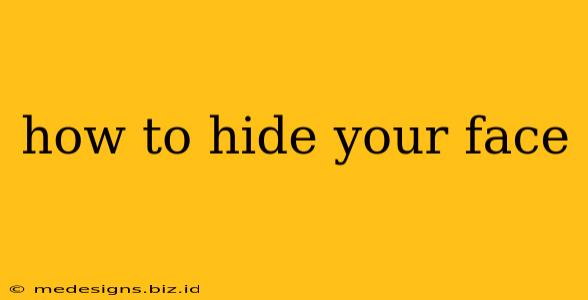In today's digitally connected world, protecting your privacy is more important than ever. Whether you're concerned about online security, avoiding unwanted attention, or simply seeking a degree of anonymity, knowing how to hide your face can be a valuable skill. This guide explores various methods, covering both online and offline scenarios.
Hiding Your Face Online: Digital Privacy Techniques
The internet offers incredible opportunities, but it also exposes us to potential risks. Here's how to maintain your anonymity online:
1. Utilizing Profile Picture Strategies:
- Blurred Images: A softly blurred image can still convey personality without revealing facial features clearly. Experiment with different levels of blur to find the right balance.
- Silhouettes and Alternative Imagery: Use silhouettes, objects, or even artwork as your profile picture instead of a direct face shot. This provides a sense of identity without showing your face.
- Avatar Creation: Many platforms offer avatar creation tools allowing you to design a unique digital representation of yourself without using your actual likeness.
2. Managing Your Online Presence:
- Privacy Settings: Actively manage your privacy settings on all social media platforms. Limit who can view your posts, photos, and information.
- Careful Information Sharing: Avoid sharing personally identifiable information (PII) online. This includes your full name, address, phone number, and birthday.
- Strong Passwords and Multi-Factor Authentication: Employ strong, unique passwords and enable multi-factor authentication whenever possible to add extra security.
3. Using Anonymizing Tools:
- VPNs (Virtual Private Networks): VPNs mask your IP address, making it harder to trace your online activity back to you.
- Proxy Servers: Similar to VPNs, proxy servers route your internet traffic through an intermediary server, hiding your real location and IP address. However, VPNs generally offer better security.
- The Tor Network: Tor is a privacy-focused network that routes your internet traffic through multiple relays, making it extremely difficult to trace your browsing activity.
Important Note: While these tools enhance privacy, they are not foolproof. Be mindful of the risks involved and use these tools responsibly.
Hiding Your Face Offline: Practical Techniques and Considerations
Offline anonymity requires a different approach. Here are some strategies:
1. Clothing and Accessories:
- Hats and Sunglasses: These are simple yet effective ways to partially obscure your face. A wide-brimmed hat and sunglasses can significantly reduce facial recognition.
- Scarves and Masks: Depending on the context, a scarf or mask can conceal your identity, especially in crowded areas.
2. Body Language and Awareness:
- Avoid Eye Contact: Reducing eye contact can make it harder for others to remember you.
- Situational Awareness: Be mindful of your surroundings and adjust your behavior accordingly. If you're concerned about being recognized, choose less frequented areas or travel during off-peak times.
3. Blending In:
- Crowd Behavior: Try to blend in with your surroundings and avoid drawing unnecessary attention to yourself.
- Dress Code: Consider adopting clothing styles that are common in the environment you are in to minimize standing out.
Legal and Ethical Considerations
While this guide discusses methods to hide your face, it's crucial to remember that anonymity should always be used ethically and legally. Hiding your face to engage in illegal activities is unacceptable and has serious consequences. Always respect local laws and regulations.
This guide offers strategies for maintaining privacy and anonymity. Remember that complete anonymity is nearly impossible, but by employing these methods, you can significantly reduce your online and offline visibility. Remember to always prioritize responsible and ethical use of these techniques.
